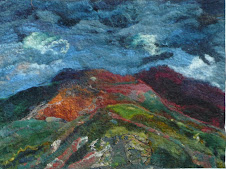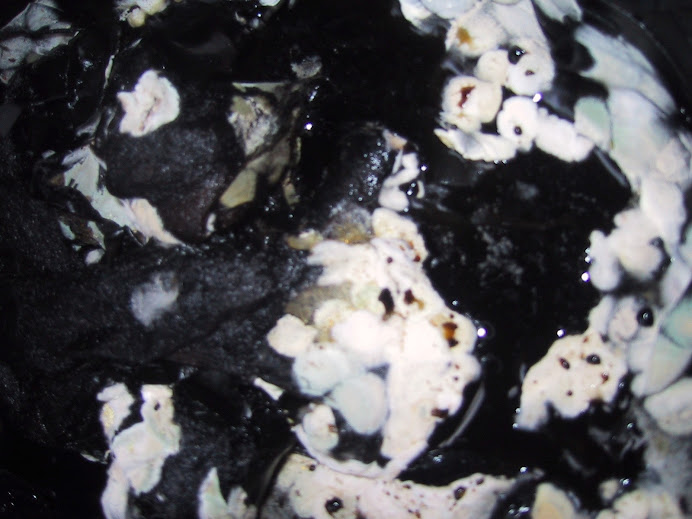The producers want to know how good the cochineal is so I volunteered to try it out. Recently I have been experimenting with different ways to dye cochineal. I have tried extracting the colour from the whole bugs by boiling in distilled water but in the end I reverted back to the way I have been doing it for a while which I found originally in Trudy Von Stralen's book "Indigo Madder and Marigold". ( Still one of the best introductions to natural dyeing around I think) . For me with soft water this seems to give me the best colour, but if you have hard water you might want to use distilled to extract the dye as cochineal does not like hard water.
So I ground 50g of cochineal bugs in a coffee grinder kept for that purpose. Trudy Von Stralen says to grind it till it is like flour and I do grind it several times. The photo looks quite gritty and grainy but in fact the fine

 powder has clumped a bit.
powder has clumped a bit.I put the ground cochineal into soak with a teaspoon of cream of tartar and left it to soak for 24 hours. Then I heated it- I used an electric casserole on the low heat so it takes about four hours to come to the boil and then boiled for about an hour and left to cool overnight.
At the same time I soaked my fibres overnight before mordanting them in 12% alum and 5% cream of tartar. (For more information on mordanting look here.)
I added a 170g of 23 micron South African Merino tops , the fibre I use in my felting and for many of my workshops. This I heated on low till it simmered and let it simmer for about an hour. Both of the South American Dyes, cochineal and log wood, are the exception to my rule of low temperature dyeing as they fix better if simmered. The fibres were then cooled rinsed and dried. I used up the exhaust dyeing more merino, a 100g of tussah silk and teeswater. Altogether the 50g of cochineal dyed 970g of fibre paler and paler colours The first colour as you can see
 from the comparison photo was as good as my usual cochineal.
from the comparison photo was as good as my usual cochineal. It will be really good to have cochineal from a nearby and known source and with a lower carbon foot print too for us in Europe. I know that cochineal production gives an income to poor Peruvian farmers but I do like to know where my dyes come from and whether workers have been paid well for their labour too.
It will be really good to have cochineal from a nearby and known source and with a lower carbon foot print too for us in Europe. I know that cochineal production gives an income to poor Peruvian farmers but I do like to know where my dyes come from and whether workers have been paid well for their labour too.I still have 50 g left so now I plan to play around with the mordants such as iron and oxalic acid. Cochineal is polychromatic and responds to different mordants givng purples grey and pinks. The best book for this is Fred Gerber's self published classic booklet Cochineal. A mine of information but very hard to get hold of.
I have just been given this link to the Association Milana



























Thank you for this post. Very informative. Beautiful colours too. i agree aout the caron footprint and workers ethics. I looked up the ook 'Indigo, Madder, Marigold' and could find a link for it. Is it still in print?
ReplyDeleteThanks for writing this up so beautifully, Helen. I will be posting my results on my website soon too. I also obtained very good results on silk and wool.
ReplyDeleteIsabella
wonderful post, gorgoeus colors-thank you for sharing your knowledge with us
ReplyDeleteHi Jasmine I believe so. I know PM Woolcraft sell it in the UK. I really like it and found it both reliable and inspiring. Her indigo - unusually- is indigo sulphonate which you make by dissolving indigo in concentrated sulphuric acid. I do make it but getting hold of the acid may be a problem.
ReplyDeleteThanks Isabella and Kathy for your comments.
Heavenly colours!!!
ReplyDeleteThank you for sharing, this will encourage me to try the cochineal I had been given but have not yet used it, also cause our tap water is said to be very hard :-(
Thank you very much for this good news, Helen.
ReplyDeleteFrom the Association Milana work to revalue this natural dye on the island of Lanzarote training the children in schools.
Thank you very much for your cooperation in this project.
The link to our partnership is www.tinamala.com
Greetings to everyone.
Juan Cazorla
What an interesting post. I am waiting for the weather to warm up a bit more so I can actually try cochineal for the very first time.
ReplyDeleteDoes the Asociacion from Lanzarote actually sell their cochineal?
I find it always tricky with this ting of bringing dyes from all over the world. Sometimes one thinks of the carbon footprint, of the conditions in which people work and live... and refuse to sustain that. and then I think that for many that is they only way they actually get an income... just thinking outloud, tricky.
Maybe Im biased because Im southamerican! ahahaha
Florcita
Thank you so much for sharing this information - very helpful to those like me who are just beginning. Your colors are GORGEOUS.
ReplyDeleteHi Ladka if your water is hard try either suing distilled water or boiling the water, leaving it overnight and pouring off the clear discarding the sediment. This is said by Michelle Wipplinger of Earthues to work but I havent't tried it having soft water.
ReplyDeleteHi Mariana I am trying to find out. I will let you know but if you are in South America is it worth it?
ReplyDeleteHi Helen, this was very interesting,and it is good to know the quality of European cochieal is good. I'm also interested in purchasing cochineal from closer in the future (of course the price also matters)-:))
ReplyDeleteSomething so is impossible
ReplyDelete